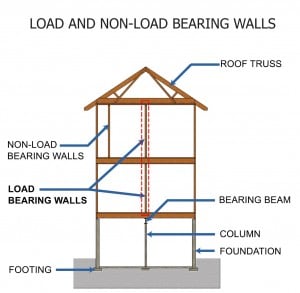This is a critical question before beginning any kind of structural renovation project such as opening up a kitchen, adding an en suite bathroom, or combining two rooms to create more flow and airiness.
A load-bearing wall is one that, as its name implies, bears a load resting upon it by conducting its weight to a foundation structure. Almost all exterior walls are load bearing, but in some instances, especially in larger homes, interior walls can be load bearing as well. Removing one of these walls can compromise your home’s structural stability, resulting in potentially disastrous consequences where the floor above can begin to sag or even collapse.

HERE'S HOW TO DO IT RIGHT:
- Start low. Preferably at the lowest floor of your home, such as the basement. If you home does not have a basement, start at the first floor.
- Examine the concrete foundation. The load-bearing walls of your home transfer their strain into the foundation, so any walls that connect into the foundation should be assumed to be load-bearing walls and should in no way be removed. Essentially, any exterior wall that rests on the foundation is considered load bearing.
- Locate the beams. These are the thick, sturdy pieces of wood or metal, and they account for holding up the majority of the house’s load, which they transfer into the foundation. If the beam spans from the foundation through the ceiling above it, then the wall is load-bearing and shouldn’t be removed.
- Look for joists. Those are the structural beams placed parallel to each other which support the floor above. Joists may be made of wood, engineered wood, steel, or concrete. If a joist meets a wall or a main support beam at a perpendicular (90o) angle, then the wall is load bearing and shouldn’t be removed.
- Big homes. In larger homes, load-bearing walls tend to be farther apart, so you should check the internal walls near the center of the house which support the floor.
Ultimately, it’s impossible to tell if an internal wall is load bearing just by examining it on the outside. Using a hammer to tap the wall is one way to determine if the wall is load bearing. If the hammer produces a hollow ring, the wall is most likely safe to remove. However, in some instances the wall sounds solid (not hollow when tapped). This may be an indication it’s load bearing, but to be certain you'll need to examine where the wall meets the ceiling joists. Again, this method may give you a sense of whether or not a wall is load bearing, but is by no means a guarantee. To be certain, you should seek the opinion of an expert who will be able to determine which walls are load bearing and which are not.
The final word. If you are thinking of undertaking a home renovation project, your best bet is to involve an architect early on. Trust us; this will save you time and money. An architect can offer you the most appropriate and economically sound design for your home. In addition to guiding your through the design, planning, and construction process, they will also handle the paperwork and keep your project on track, invariably saving you money and granting you peace of mind.
Have a question to ask an architect? Send it to dixonadvisoryusa@dixon.com.au.
 201 366 8692
201 366 8692






![The Five Must-Check Apartment Sites for Renters [Updated in 2019]](https://www.dixonleasing.com/hubfs/Homes%20by%20Dixon%20Images/Rent%20Savvy/RentSavvy_MustCheckSites_Large.jpg)

